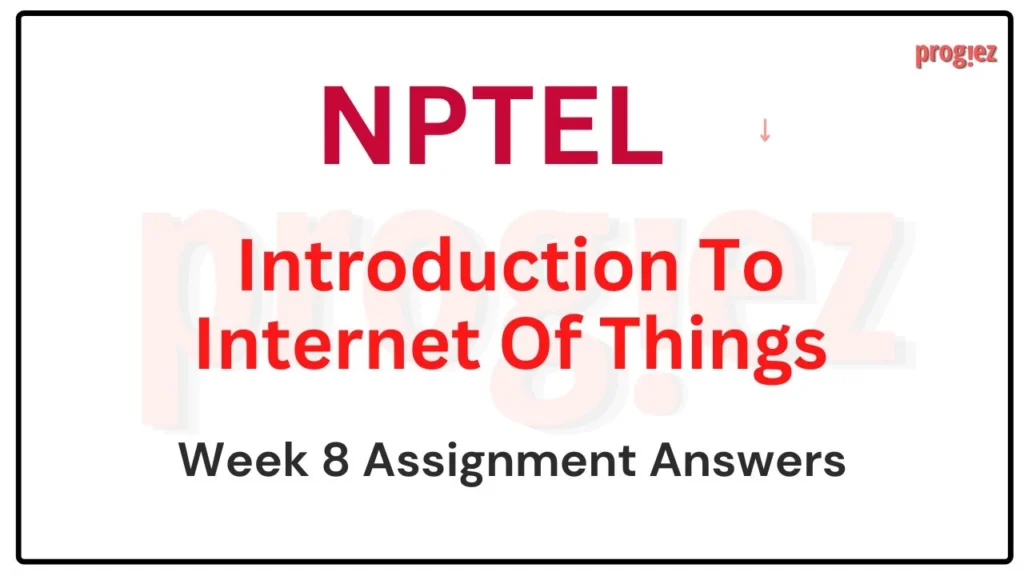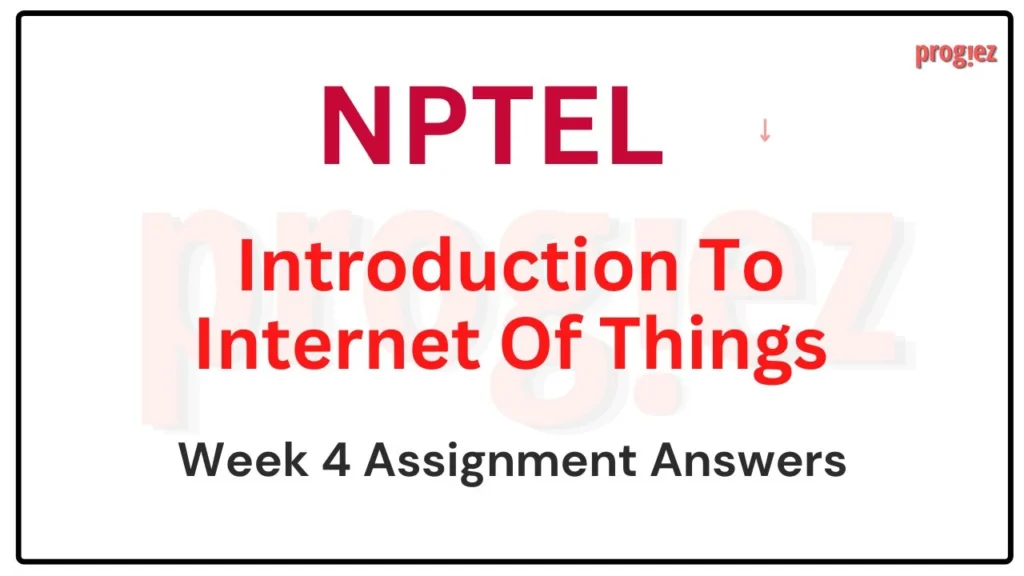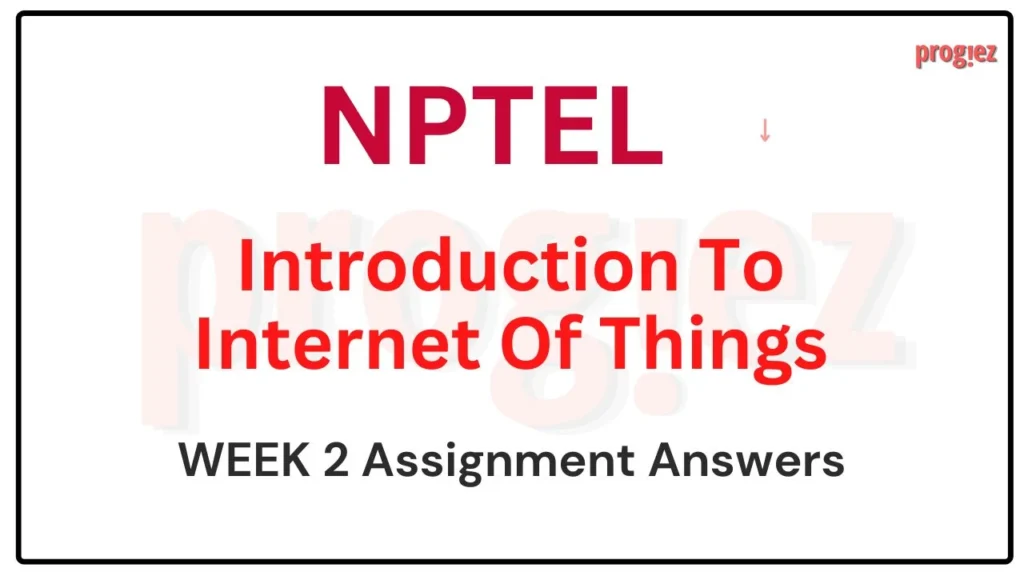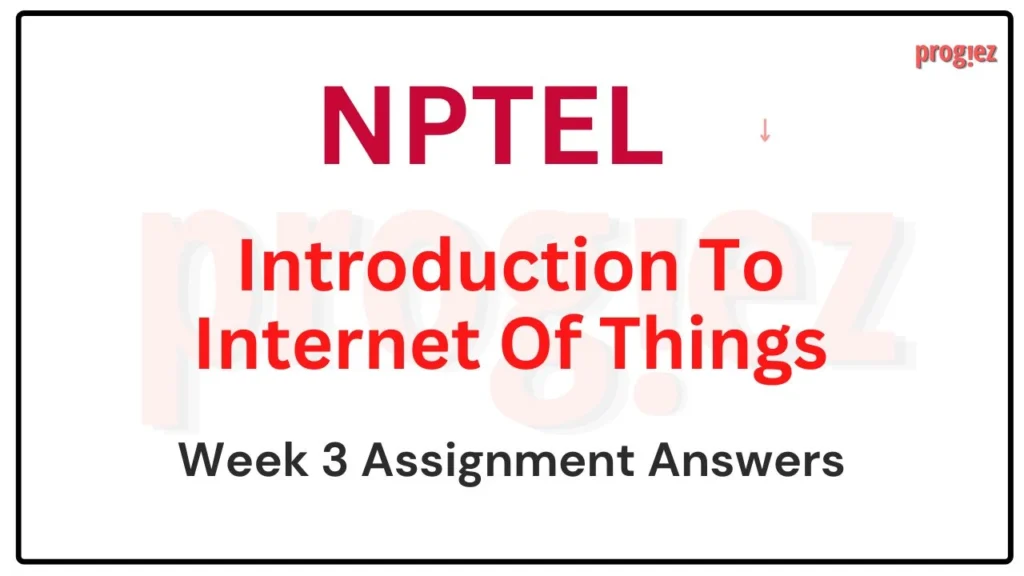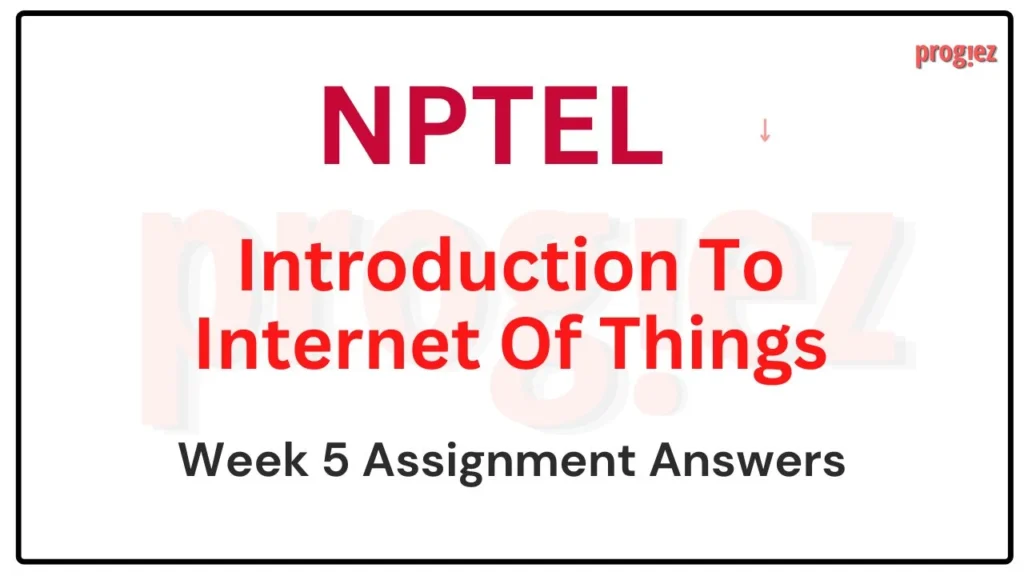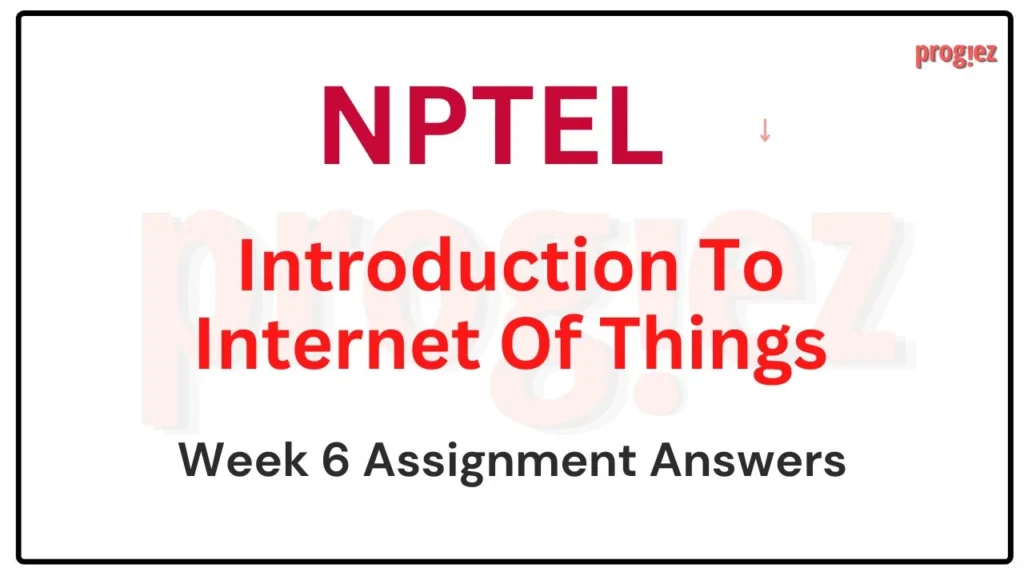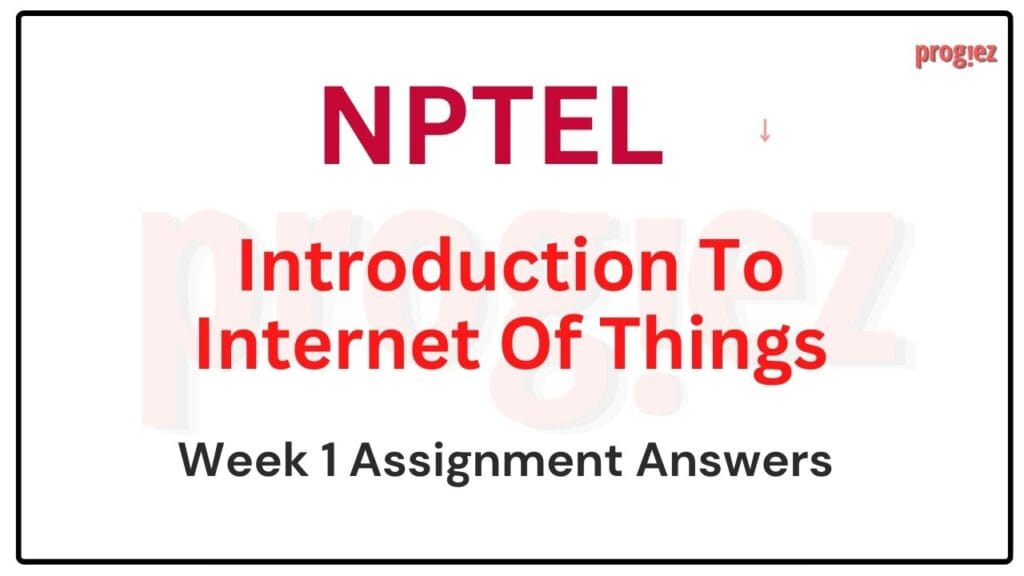Introduction To Internet Of Things Week 9
Session: JAN-APR 2024
Course Name: Introduction To Internet Of Things
Course Link: Click Here
For answers or latest updates join our telegram channel: Click here to join
These are Introduction To Internet Of Things Week 9 Assignment 9 Answers
Q1. Which of the following is not a component of OpenStack?
a. Suse
b. Nova
с. Swift
d. All of these
Answer: a. Suse
Q2. Where is the sensed data sent for further processing in WSNs?
a. Client node
b. Central node
с. Collect node
d. Sink node
Answer: d. Sink node
Q3. Select the statement(s) that denote the advantages of cloud computing.
Statement I: Elasticity
Statement II: Pay-per-use
Statement III: Self Service
a. Statement I
b. Statement II
c. Statements I, II, and III
d. None of these
Answer: c. Statements I, II, and III
For answers or latest updates join our telegram channel: Click here to join
These are Introduction To Internet Of Things Week 9 Assignment 9 Answers
Q4. Which of the following is a limitation of WSN?
a. Price
b. Post deployment maintenance
c. Battery lifetime
d. All of these
Answer: d. All of these
Q5. The managerial role is played by __________ in sensor-cloud architecture.
a. End-users
b. Sensor-Cloud Service Provider
c. None of these
d. All of these
Answer: b. Sensor-Cloud Service Provider
Q6. The optimal composition of __________ is a management issue in sensor-cloud.
a. Logistics
b. Pricing
c. Caching
d. Virtual sensor nodes
Answer: d. Virtual sensor nodes
For answers or latest updates join our telegram channel: Click here to join
These are Introduction To Internet Of Things Week 9 Assignment 9 Answers
Q7. Who coined the term Fog computing?
a. IBM
b. CISCO
с. All of these
d. None of these
Answer: b. CISCO
Q8. What are the issues related to the current cloud model?
a. Volume
b. Latency
с. All of these
d. None of these
Answer: с. All of these
Q9. Sensor data is processed in the cloud before it is sent to the fog.
a. True
b. False
Answer: b. False
For answers or latest updates join our telegram channel: Click here to join
These are Introduction To Internet Of Things Week 9 Assignment 9 Answers
Q10. What is the type of received data according to which Fog nodes work?
a. Non-time sensitive data
b. Very time-sensitive data
с. Less time-sensitive data
d. All of these
Answer: d. All of these
Q11. Which of the following are the advantages of Fog?
a. Quick decision making
b. Nodes can be mobile
c. Reduces the risk of latency
d. All of these
Answer: d. All of these
Q12. Which of the following requires the analysis at the nearest node?
a. Non-time sensitive data
b. Most time-sensitive data
c. Less time-sensitive data
d. None of these
Answer: b. Most time-sensitive data
For answers or latest updates join our telegram channel: Click here to join
These are Introduction To Internet Of Things Week 9 Assignment 9 Answers
Q13. Fog nodes cannot connect and leave the network when necessary.
a. True
b. False
Answer: b. False
Q14. Which of the following is used by the fog applications to increase the speed of service accessibility?
a. Low power
b. Good network connection
c. Accelerators
d. Analytics
Answer: c. Accelerators
Q15. Fill in the blank. The concept of ___________ enables physical hardware to be shared among multiple entities.
a. Hardware virtualization
b. Software virtualization
с. Module virtualization
d. All of these
Answer: a. Hardware virtualization
For answers or latest updates join our telegram channel: Click here to join
These are Introduction To Internet Of Things Week 9 Assignment 9 Answers
More Weeks of Introduction To Internet Of Things: Click here
More Nptel Courses: Click here
Session: JULY-DEC 2023
Course Name: Introduction To Internet Of Things
Course Link: Click Here
These are Introduction To Internet Of Things Week 9 Assignment 9 Answers
Q1. Which component of OpenStack do you use to access all the other components?
a. Horizon
b. Glance
c. Neutron
d. None of these
Answer: a. Horizon
Q2. Which among the following is NOT a component of OpenStack?
a. Horizon
b. Heat
c. Plasma
d. Neutron
Answer: c. Plasma
Q3. Sensor cloud is simply dumping and organizing of sensor data on cloud computing platforms.
a. True
b. False
Answer: b. False
These are Introduction To Internet Of Things Week 9 Assignment 9 Answers
Q4. Which among the following are limitations of traditional Wireless Sensor Networks (WSNs)?
a. Procurement Issues
b. Deployment Issues
c. Maintenance Issues
d. All of the given
Answer: d. All of the given
Q5. In a typical sensor cloud architecture, the sensor cloud infrastructure that provides the virtualization lies __________________
a. At the same layer as physical sensor devices
b. At the application layer
c. In between the physical sensor layer and the application layer
d. Sensor cloud does not support virtualization
Answer: c. In between the physical sensor layer and the application layer
Q6. Generally speaking, Sensor Cloud Service Providers (SCSPs) are also always the owners of the physical sensors
a. Yes
b. No
Answer: b. No
These are Introduction To Internet Of Things Week 9 Assignment 9 Answers
Q7. In a typical sensor cloud architecture with virtualization, one virtual sensor can be associated with how many physical sensors?
a. Only one
b. One or more than one
c. None
d. Only two
Answer: b. One or more than one
Q8. Sensor virtualization aims to achieve more _____________ in providing sensor based services
a. Complexity
b. Flexibility
Answer: b. Flexibility
Q9. Suppose that you want to start a business to provide some IoT based application, but you do not have the means to develop the application layer logic, neither you have the means to purchase and deploy physical sensors. You can however, rent cloud servers for use and write interface logic for interfacing with other modules. Which among the following actors will be the most suitable for you?
a. Physical sensor owner
b. Application layer developer
c. Sensor Cloud Service Provider (SCSP)
d. You cannot start the business
Answer: c. Sensor Cloud Service Provider (SCSP)
These are Introduction To Internet Of Things Week 9 Assignment 9 Answers
Q10. Which among the following is implemented along with sensor cloud to make its services and performance better?
a. Cashing
b. Caching
c. Casing
d. Calling
Answer: b. Caching
Q11. Which among the following cases is most likely to reduce the overall price of sensor-cloud implementation provided that the data traverses through multiple sensor hops starting from the origin sensor to the sink node, and provided that all owners are honest and charge for only what is required?
a. If physical sensors are owned by multiple owners with high profit margin
b. If all physical sensors are owned by a single owner with uniform profit margin
Answer: b. If all physical sensors are owned by a single owner with uniform profit margin
These are Introduction To Internet Of Things Week 9 Assignment 9 Answers
Q12. Fog computing is aimed to replace cloud computing completely and has no scope for integration with cloud
a. True
b. False
Answer: b. False
Q13. Suppose data from an IoT device first goes to Fog layer for some basic processing, after which it goes to Cloud layer for advanced processing, then the processed data comes back to the Fog layer and then, it finally comes back to the origin sensor node. In the return journey no processing of data takes place anywhere, just transfer of data takes place.
If ‘Tf’ is the time taken by the data to travel from sensor to fog and vice versa, and ‘Tc’ is the time taken by the data to travel from fog to cloud and vice versa, ‘Tfp’ is the data processing time at fog and ‘Tcp’ is the data processing time at cloud, what is the total round trip time ‘T’ taken by data starting from the origin sensor node, processing the data and then back to the sensor node after being processed.
a. T = Tf + Tc + Tfp + Tcp
b. b. T = Tf + Tc
c. T = 2(Tf + Tc) + Tfp + Tcp
d. T = 4(Tf + Tc + Tfp + Tcp)
Answer: c. T = 2(Tf + Tc) + Tfp + Tcp
These are Introduction To Internet Of Things Week 9 Assignment 9 Answers
Q14. Consider the standard Fog computing architecture. In which of the following layer will ‘very time sensitive data’ be processed?
a. Nearest fog node
b. Distant aggregate fog node
c. Cloud
d. Does not matter
Answer: a. Nearest fog node
Q15. “Network, Accelerator, Compute and Storage” constitute the part of which view of fog computing architecture, as defined by OpenFog Consortium Architecture Working Group?
a. System View
b. Node View
c. Software View
d. None of these
Answer: b. Node View
These are Introduction To Internet Of Things Week 9 Assignment 9 Answers
More Weeks of Introduction To Internet Of Things: Click here
More Nptel Courses: Click here
Session: JAN-APR 2023
Course Name: Introduction To Internet Of Things
Course Link: Click Here
These are Introduction To Internet Of Things Week 9 Assignment 9 Answers
Q1. Openstack is a free open source software for cloud framework simulation and experimentation with
a. True
b. False
Answer: a. True
Q2. Which among the following is NOT a component of OpenStack.
a. Horizon
b. Heat
c. Plasma
d. Neutron
Answer: c. Plasma
Q3. You cannot ping your OpenStack instance from an outside network unless you connect your instance with the public network through a
a. Router
b. Firewall
c. Repeater
d. Load balancer
Answer: a. Router
These are Introduction To Internet Of Things Week 9 Assignment 9 Answers
Q4. Virtualized resources within the OpenStack simulator that you can define, set parameters of and deploy within OpenStack are also known as
a. Instances
b. Files
c. Hypervisors
d. Sketches
Answer: a. Instances
Q5. The SCSP in sensor clouds is responsible for caching the data in the databases.
a. True
b. False
Answer: a. True
Q6. Select the correct option for replacing the box (in red) in the following architecture for sensor cloud user organization view.

a. User credentials
b. Template display
c. Template view
d. User view
Answer: b. Template display
These are Introduction To Internet Of Things Week 9 Assignment 9 Answers
Q7. Which among the following is the principal feature of sensor clouds, with respect to sensor nodes?
a. Sensor monitoring
b. Sensor instantiation
c. Sensor virtualization
d. Sensor collection
Answer: c. Sensor virtualization
Q8. Caching in sensor cloud provide no benefit over regions with slow environmental monitoring rate.
a. True
b. False
Answer: b. False
Q9. How many different types of caching mechanism are there in sensor cloud?
a 1
b. 4
c. 2
d. 3
Answer: c. 2
These are Introduction To Internet Of Things Week 9 Assignment 9 Answers
Q10. Virtual sensors within a sensor cloud have communication interfaces with ________.
a. Only the physical sensors below them
b. Only the end-user applications above them.
c. Both physical sensors below and applications above.
d. Neither the physical sensors, nor the applications above.
Answer: c. Both physical sensors below and applications above.
These are Introduction To Internet Of Things Week 9 Assignment 9 Answers
Q11. Data from an IoT device 1s transferred to cloud via a network, which 1s then processed at the cloud and then a response is sent back to the IoT device from the cloud after processing. The time it takes for one-way data transfer between the node and cloud is 10s and the data processing time at the cloud is ‘x’ seconds. It takes a total of 25s for the entire to and fro transfer of data between the sensor and cloud along with processing at the cloud. What is the value of x?
a. 10s
b. 5s
c. 15s
d. 20s
Answer: b. 5s
Q12. In IoT, temporal sensitivity of data plays an important role
a. True
b. False
Answer: a. True
These are Introduction To Internet Of Things Week 9 Assignment 9 Answers
Q13. Extremely time sensitive data in IoT should be processed and analyzed ________.
a. Farthest away from source
b. Closest to the source
c. Distance between source and place of analysis does not matter
d. None of these
Answer: b. Closest to the source
These are Introduction To Internet Of Things Week 9 Assignment 9 Answers
Q14. Which among the following is a view of a Fog Computing Architecture?
a. Node View
b. System View
c. Software View
d. All of these
Answer: d. All of these
These are Introduction To Internet Of Things Week 9 Assignment 9 Answers
Q15. Which among the following is true?
a. Fog computing acts as a complement to cloud computing.
b. Fog computing is a replacement for cloud computing.
c. Fog computing and cloud computing are the same.
d. Fog computing is more powerful than cloud computing (with respect to resources).
Answer: a. Fog computing acts as a complement to cloud computing.
These are Introduction To Internet Of Things Week 9 Assignment 9 Answers
All weeks of Introduction to Internet of Things: Click Here
More Nptel courses: Click Here
Session: Jul-Dec 2022
These are Introduction To Internet Of Things Week 9 Assignment 9 Answers
Course Name: Introduction To Internet Of Things
Link to Enroll: Click Here
1) The OpenStack cloud simulation framework provides an interactive Graphical User Interface (GUI)
a. True
b. False
Answer: a. True
2) Virtualized resources within the OpenStack simulator that you can define, set parameters of and deploy within OpenStack are also known as
a. Instances
b. Files
c. Hypervisors
d. Sketches
Answer: c. Hypervisors
These are Introduction To Internet Of Things Week 9 Assignment 9 Answers
3) If you want to connect your OpenStack instance with the external public network (like the Internet), you would need to connect the following between your instance and the public network
a. Database
b. File
c. Memory
d. Router
Answer: d. Router
4) Which among the following is NOT a part of a sensor node connected to a wireless sensor network.
a. Sensing unit
b. Gaming unit
c. Processing unit
d. Communication unit
Answer: b. Gaming unit
These are Introduction To Internet Of Things Week 9 Assignment 9 Answers
5) Consider that you have two types of sensors, soil monitoring sensor for smart farming and temperature sensor for smart industry. The concept that the correct (right) type of sensor must be deployed only at their correct and appropriate physical location suitable as per their functionalities is known as
a. Right way of deployment
b. Right place of deployment
c. Right time of deployment
d. None of these
Answer: b. Right place of deployment
6) Sensor-as-a-Service (Se-aaS) is an exciting new concept that brings the service models of cloud computing to traditional IoT sensor networks. In this aspect, which among the following forms an essential component of a Se-aaS architecture.
a. Sensor marketing
b. Sensor division
c. Sensor virtualization
d. Sensor manufacturing
Answer: b. Sensor division
These are Introduction To Internet Of Things Week 9 Assignment 9 Answers
7) Considering the end-to-end architecture of a WSN, from the physical sensor nodes right up to the users, sensor-cloud supports different entities to have ownership of the different layers and components simultaneously.
a. True
b. False
Answer: b. False
8) In sensor cloud architecture the Sensor Cloud Service Provider (SCSP) is logically situated at the following position of the architecture
a. In the same level as the physical sensors
b. In between the physical sensors and the user layer
c. In the same level as the users
d. None of these
Answer: b. In between the physical sensors and the user layer
These are Introduction To Internet Of Things Week 9 Assignment 9 Answers
9) In sensor cloud, the association between virtual sensor instances and the corresponding physical sensors follows
a. one to one mapping
b. one to many mapping
c. many to one mapping
d. many to many mapping
Answer: b. one to many mapping
10) Dynamic caching mechanism improves the flexibility and efficiency of sensor cloud.
a. True
b. False
Answer: b. False
These are Introduction To Internet Of Things Week 9 Assignment 9 Answers
11) With respect to the caching based architecture of a sensor cloud, the External Cache (EC) has a direct data connection with which among the following
a. The Internal Cache (IC)
b. The user applications
c. Physical sensors
d. Both physical sensors and Internal Cache (IC)
Answer: b. The user applications
12) Data from an IoT device is transferred to cloud via a network, which is then processed at the cloud and then a response is sent back to the IoT device from the cloud after processing. The time it takes for one way data transfer between the node and cloud is 10s and the data processing time at the cloud is ‘x’ seconds. It takes a total of 25s for the entire to and fro transfer of data between the sensor and cloud along with processing at the cloud. What is the value of x?
a. 10s
b. 5s
c. 15s
d. 20s
Answer: c. 15s
These are Introduction To Internet Of Things Week 9 Assignment 9 Answers
13) There are two types of sensor data, A and B. A is time sensitive that is required to be processed immediately, while B is not time sensitive and can tolerate longer time for processing. As per the standard utilities of cloud and fog computing, which among the following options show the correct processing locations for A and B.
a. A : Cloud, B : Fog
b. A : Fog, B : Cloud
c. None of these
d. Both of these
Answer: b. A : Fog, B : Cloud
14) There can be multiple fog nodes in between the physical sensor layer at the bottom and the cloud layer at the top.
a. True
b. False
Answer: a. True
These are Introduction To Internet Of Things Week 9 Assignment 9 Answers
15) Which among the following is/are a potential problem and challenge in fog computing?
a. Power consumption
b. Data security
c. Reliability
d. All of these
Answer: d. All of these
These are Introduction To Internet Of Things Week 9 Assignment 9 Answers
More NPTEL Solutions: https://progiez.com/nptel

